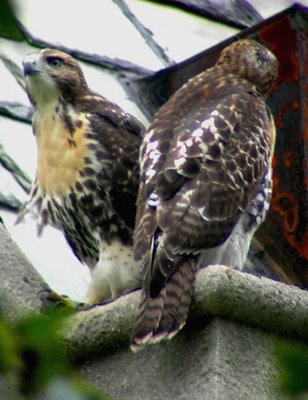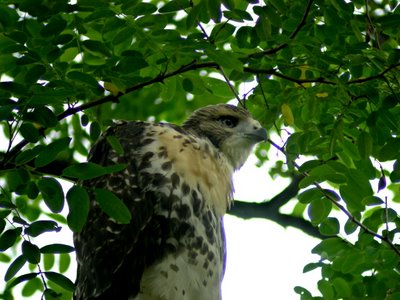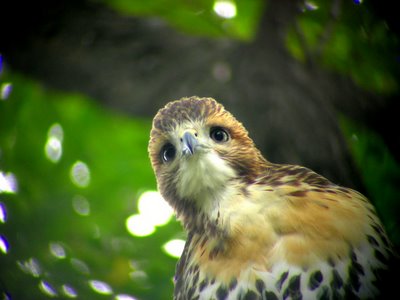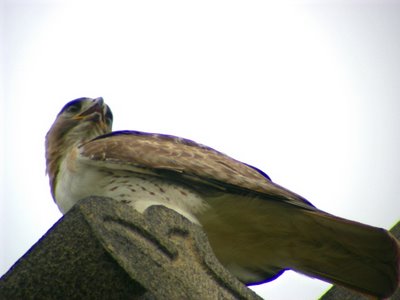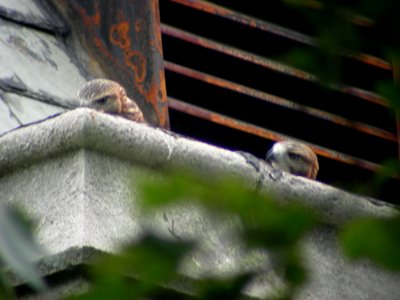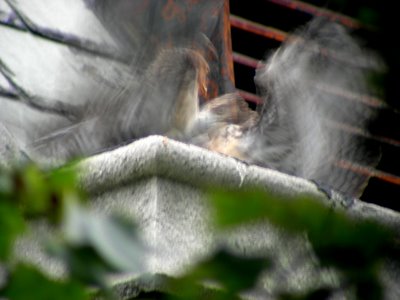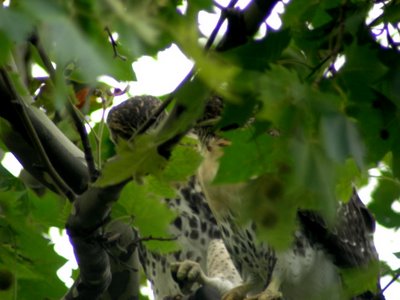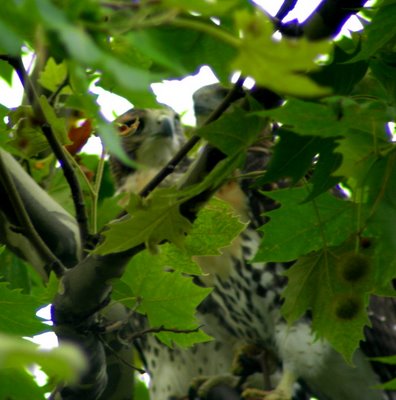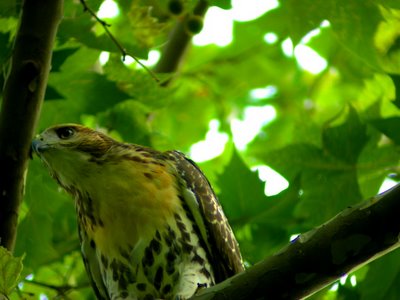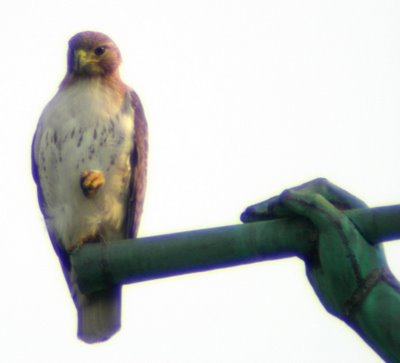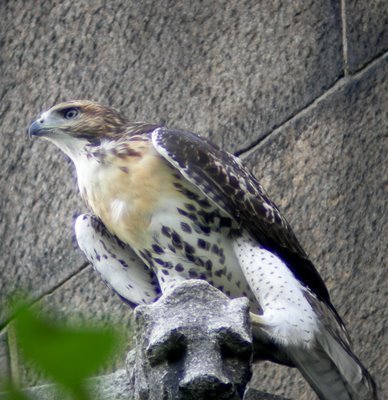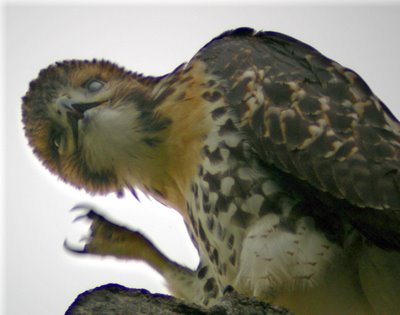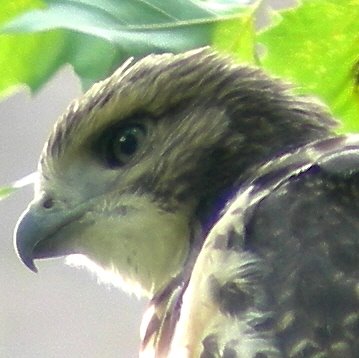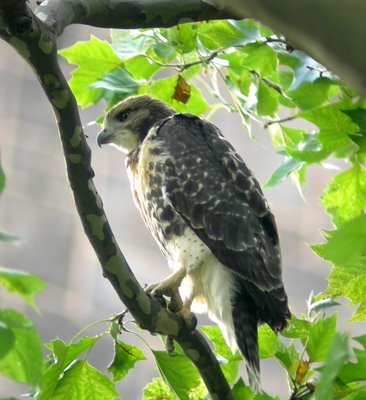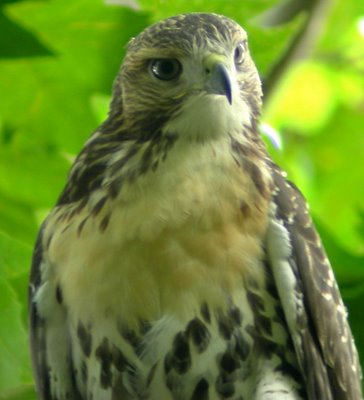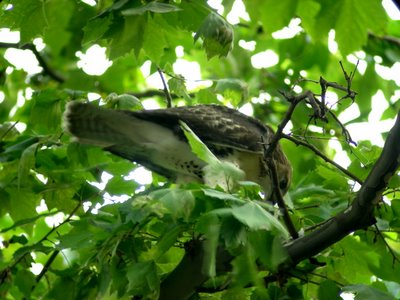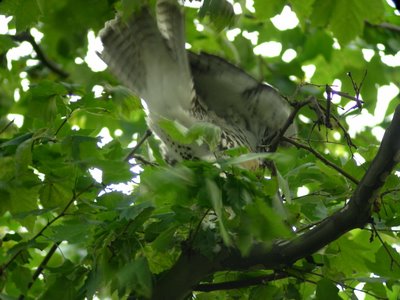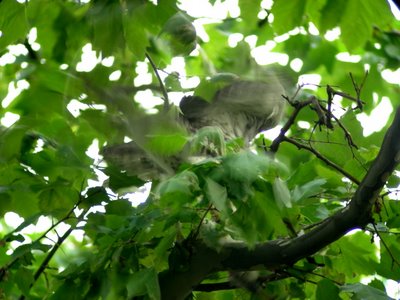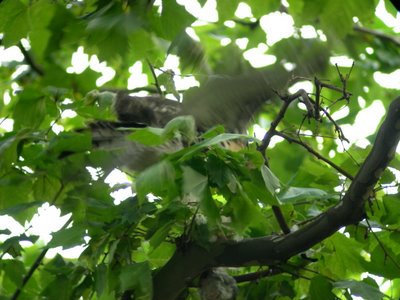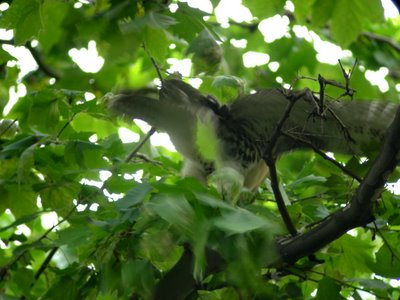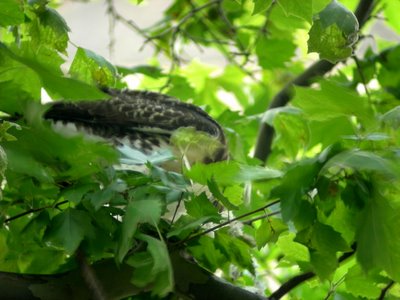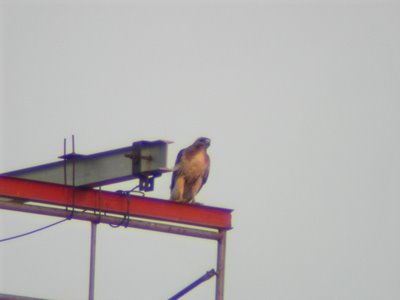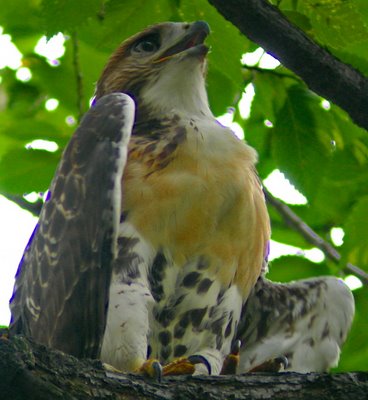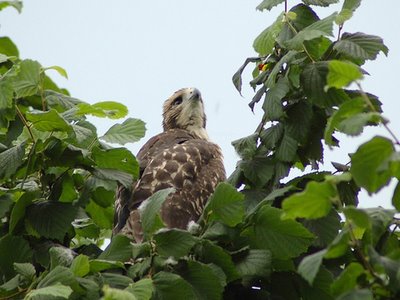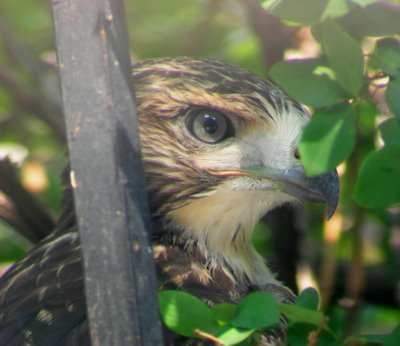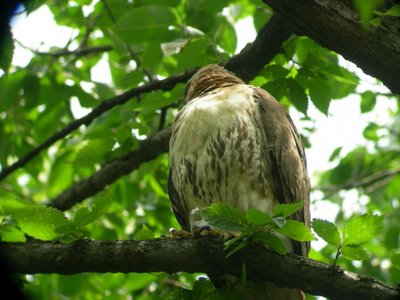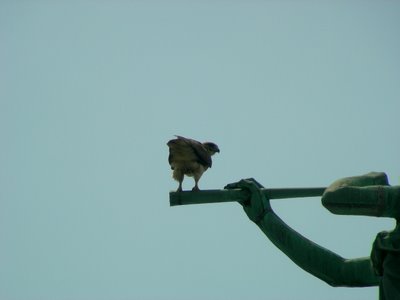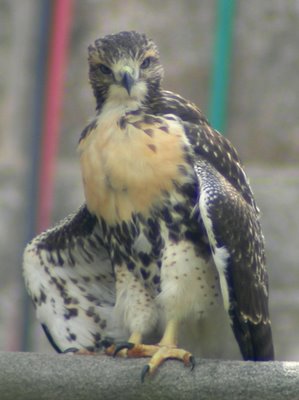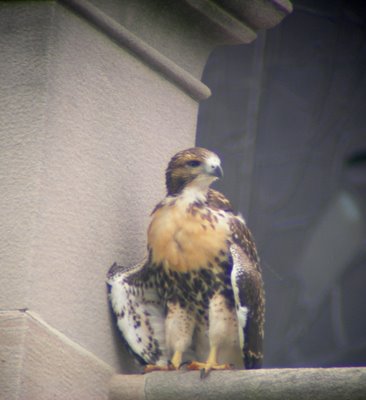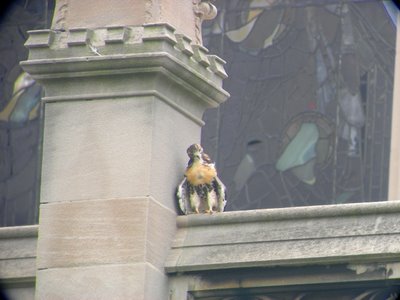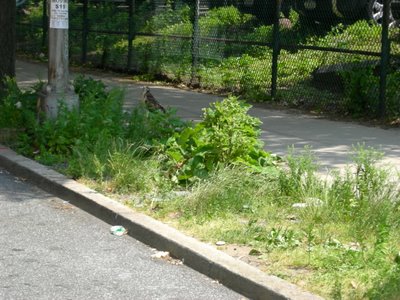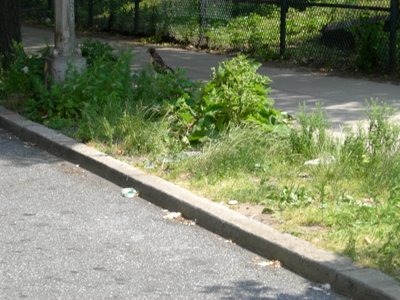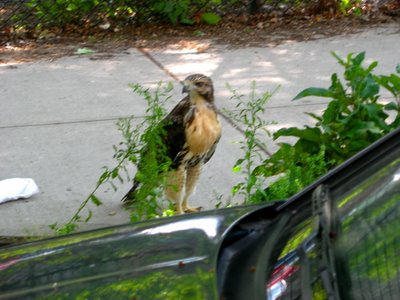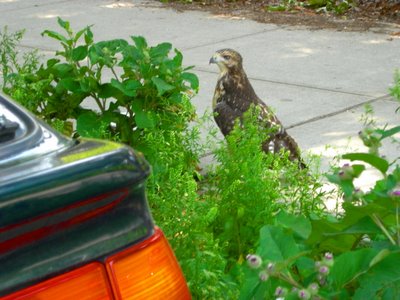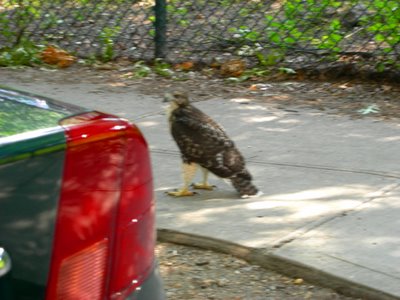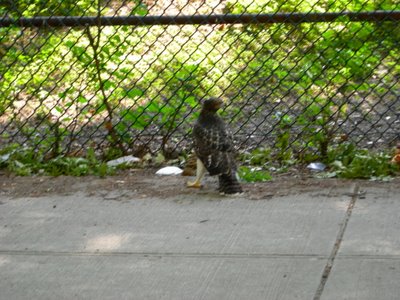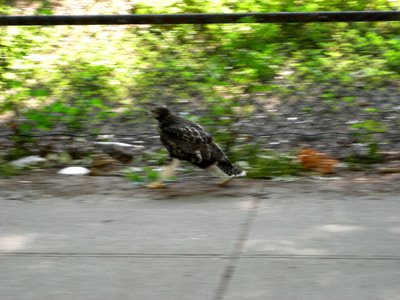 PHOTOGRAPH BY DONEGAL BROWNEA Mother's work is never done.
PHOTOGRAPH BY DONEGAL BROWNEA Mother's work is never done.Mom, vigilant, on St. Savior's Cross.
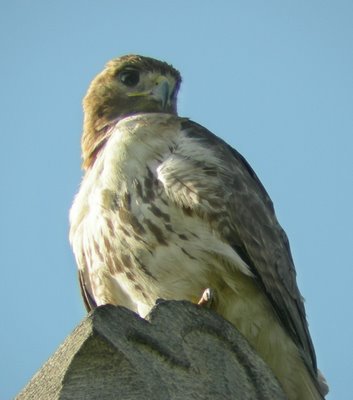 PHOTGRAPH BY DONEGAL BROWNEMom keeps her eye on a dog.
PHOTGRAPH BY DONEGAL BROWNEMom keeps her eye on a dog. PHOTOGRAPH BY DONEGAL BROWNEAnd another...
PHOTOGRAPH BY DONEGAL BROWNEAnd another...
Robert Schmunk, uptown hawkwatcher and contributer of wonderful photos to the blog, took some time on his lunch hour today to do a "Red-tail Check" on The Cathedral Family.
Here's his report.Short Wednesday afternoon report...
Wandered around the Cathedral from about 2:00 to 2:40. No sign of any of the hawks, but the sun is brutal unless you stay in a shady spot. I figured that all the hawks were perched somewhere cool until later in the day. Walking back to the office, I stopped on 112th St a few feet off Amsterdam and looked back towards St Luke's, and spotted a hawk. I head back over that direction, and found it was Mom sitting on a rooftop railing on 114th St. about 60 ft off Morningside Drive. And that was it.
rps
And here are the observations of my short visit...D.B.4:37 pm Mom is perched on the St. Savior Cross above the Chapel of the same name at the rear of the Cathedral. She is in the sun but not panting though she does have rather large circles under her eyes and her feathers have that rumpled look that females get from a long season of sitting eggs and caring for a nest full of young. 4:45pm A few begging calls are heard from the north of Mom. She continues to sit on the cross. She is very alert to dogs on the sidewalk below her and I suspect that if one of her fledges were on the ground and an unleashed dog took after it that she would swoop down to protect it. 5:18pm I've crossed the street to pursue other sightings when suddenly a mature RT comes zooming out of the trees, red tail flashing, at 114th and zips west. I presume it's Dad as Mom doesn't seem concerned but I can't positively say.5:42pm I'm searching the roofs near Mom when I notice her beak is moving. I hurry closer and she is making a soft , chuck, chuck, sound. I then remember the vocalization from last season as something Charlotte, the female of the Trump Parc pair, made as a sort of soothing sound to her eyasses on the nest. Seems to be used for fledglings as well, as it turns out. But I've searched every square inch of visible perches for the fledges and for the life of me, I just can't find the young that she's "chucking" for. I guess they are being soothed in invisible from the ground shady corners.
6:15pm My own version of a fledgling, Samantha, calls, and I exit. PHOTOGRAPH BY DONEGAL BROWNE
PHOTOGRAPH BY DONEGAL BROWNERemember when I wondered why Youngest's toes had red tips? I didn't know if it was heat related, or residue, or what. I asked John Blakeman, who has intimate knowledge of all things Red-tail, and he said it had nothing to do with the temperature. Well, look at Mom's foot in the photograph above that I took today. The "red" is far more irregular than Youngest's "tips" but it has the same color and look. Residue from a meal.
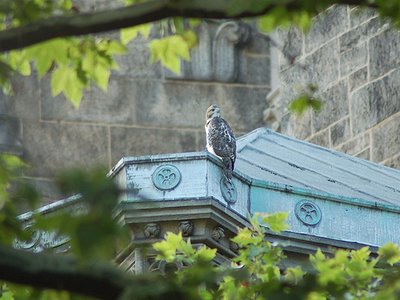 PHOTOGRAPH BY ROBERT SCHMUNKJust after I exited, Robert Schmunk and four other stalwart Hawkwatchers took up the observation task. On their arrival Mom is still on the St. Savior Cross. Robert's evening report-
PHOTOGRAPH BY ROBERT SCHMUNKJust after I exited, Robert Schmunk and four other stalwart Hawkwatchers took up the observation task. On their arrival Mom is still on the St. Savior Cross. Robert's evening report-Walking down Morningside Drive, I discovered a fledgling perched on an eave of the roof of St. Martin Chapel (one chapel clockwise from St. Savior). (See link below)
(New uptown hawkwatcher, Paula Nast reports that at 6:41 Divine Dad flew in and perched on Gabriel. D.B.)Shortly before 7 p.m., things got exciting. First Dad flew off toward CentralPark, then Mom swooped down over Morningside Park. Then we see that the fledgling on St. Martin's Chapel is getting active, moving from one roof corner to another and then back. A couple minutes later the fledgling decides to fly and makes for the roof of the north wing of the Cathedral School!
And to add to the excitement the other fledgling comes out of nowhere to join her. The second had apparently been hiding somewhere just out ofview, perhaps over on the roof of St. Ambrose Chapel (one clockwise from St. Martin).
Unfortunately the gables on the Cathedral School stick up higher than the roof, which with the tree cover makes taking pix difficult. As we're trying to do so, one of the fledglings flies to the roof of the south wing of the Cathedral School. At that point, all five hawkwatchers completely lose track of where the fledglings are, and we have people on both sides of the street pacing slowly around trying to find them.
Around 7:15, someone noticed that Mom is atop the water tower on the roof of 412 West 110th St. After that, everyone moseyed around to Amsterdam Ave. and we went exploring for hawks on the south side of the Cathedral campus. While we're doing so, Mom shifts from the water tower over to Gabriel's horn.
Close to 7:30, Bruce finds one of the fledglings perched on an eave of the roof on the backside of the Cathedral School. We admire her for awhile, point her out to some kids who have been playing basketball on the school court, and then it's time to leave. As the day comes to a close, we see Mom still perched on Gabriel's horn, but being harassed (and ignoring it) by a smaller bird that alternately perches on one of Gabriel's wings, chirps loudly, and tries to buzz Mom.
rps
http://flickr.com/photos/rbs10025/172345305/in/set-72157594167287989/And....Ben Cacace Sends In A CorrectionFor those new folks who may not know Ben, after all he does tend towards a lower profile than some, Ben Cacace has been watching Pale Male and Company since 1996, only a few years shy of the very beginning of their urban invasion. He is also the observer who watched and carefully recorded the activities of the Trump Parc Hawks when most eyes were glued to the Fifth Avenue Pair and of late has been the vanguard when it comes to the observation of the GM Building Peregrines.
Now Ben is kind of a stickler. Okay, not kind of, he is a stickler. Accuracy in all things is important. Whether in field notes or in word usuage, correct is correct. Having had some stickler moments myself, I can agree with him.
Though let me add, Ben is not a Dreaded Nitpicker. There is no sense of "Gotcha", or smugness, or weird competition, when an email arrives in one's box from Ben. Therefore I opened this one with anticipation to find out just which incorrect detail had slipped through this time.
Ben writes in regards to my whimsical use of "eyass crossing guards"...
Please note that referring to an eyas that is no longer in the nest is not correct.
An eyas (eyases) are nestlings / unfledged hawks.
See Merriam-Webster below:
Main Entry: ey·as Etymology: Middle English, alteration (by incorrect division of a neias) of neias, from Middle French niais fresh from the nest, from (assumed) Vulgar Latin nidax nestling, from Latin nidus nest -- more at NEST: an unfledged bird; specifically : a nestling hawk.
And he, as usual, is absolutely correct. Thanks, Ben!And here is Ben's blog address- http://novahunter.blogspot.com/

